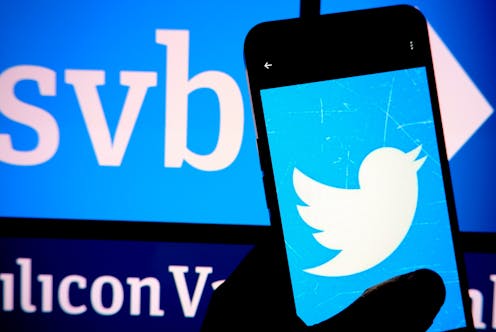Twitter played a role in the collapse of Silicon Valley Bank – new research
- Written by Tony Cookson, Associate Professor of Finance, University of Colorado Boulder

The Research Brief[1] is a short take about interesting academic work.
The big idea
Prior to Silicon Valley Bank’s March 10, 2023, collapse[2], conversations on Twitter among investors about the bank spiked – helping fuel the SVB bank run. As we explain in our new working paper, “Social media as a bank run catalyst[3],” those tweets also destabilized other financial institutions with weak balance sheets.
The number of tweets mentioning “SIVB,” the bank’s stock ticker[4], increased sharply on March 9 around 9 a.m EST. That was roughly two and a half hours before tweets mentioning “SVB” or “Silicon Valley Bank,” which were part of a more general-interest discussion, began.
That spike in investor tweets coincided with the rapid drop in the bank’s stock price on March 9, which continued in after-hours trading and before the market opened[5] the next morning. Trades in SVB’s stock were halted on March 10, the day the bank collapsed.
Together with several other colleagues, we grouped U.S. banks by the number of tweets posted about them and by their vulnerability to a potential bank run. To measure vulnerability, we multiplied losses the banks incurred due to the string of interest rate increases that began in March 2022[6] by the proportion of their deposits that were below the Federal Deposit Insurance Corp.‘s insurance limit of $250,000 per account[7].
We found that shares of banks with a lot of Twitter activity in January and February incurred much larger declines in March. This effect was stronger for the group of banks with the most vulnerability. One of them was First Republic Bank, which subsequently failed[8] on May 1.
When we looked at what happened to the stocks of all the banks with vulnerable balance sheets from March 6 to March 13, the one-third of banks with the most tweets experienced declines in their share prices on average about twice as large as the others.
Why it matters
U.S. policymakers have acknowledged that social media[9] may have played a role in Silicon Valley Bank’s demise.
Existing knowledge about bank runs comes mainly from banking distress during the Great Depression[10]. Back then, word of mouth, media coverage and public signals, such as long lines outside of banks, spread panic among bank customers.
The breadth of the audience and the quick spread of ideas make social media distinct from newspapers and broadcast news since traditional media outlets mostly rely on one-way communication from official sources to the general public.
This will surely remain an important issue for banks, especially as other financial institutions face issues[11] similar to those that felled SVB.
What other research is being done
A report on SVB’s failure that the Federal Reserve[12] released on April 28 underscored many of the points we made in our paper. It highlights poor risk management by SVB in combination with a large fraction of depositors concentrated in the Silicon Valley startup community, who are often very active and highly connected on social media.
Another team of scholars, led by University of Pennsylvania finance professor Itamar Drechsler[13], determined that the recent growth of uninsured deposit accounts[14] can destabilize banks.
As ongoing research by a team of researchers at Columbia University and the University of Chicago[15] suggests, this risk may further be amplified by the rise of fully digital banks and mobile banking apps.
What is not known
Depositors who rapidy withdrew money from SVB also reportedly relied on[16] private communication channels[17], such as group text messages, Slack and WhatsApp, as well as phone calls, to share their fears and concerns. But since there is no publicly available data, it is hard to find out what role those other less formal conversations played in precipitating the SVB bank run.
References
- ^ Research Brief (theconversation.com)
- ^ Silicon Valley Bank’s March 10, 2023, collapse (www.fdic.gov)
- ^ Social media as a bank run catalyst (dx.doi.org)
- ^ stock ticker (www.investopedia.com)
- ^ after-hours trading and before the market opened (www.cnbc.com)
- ^ interest rate increases that began in March 2022 (www.nber.org)
- ^ of $250,000 per account (www.fdic.gov)
- ^ First Republic Bank, which subsequently failed (www.fdic.gov)
- ^ policymakers have acknowledged that social media (money.yahoo.com)
- ^ banking distress during the Great Depression (theconversation.com)
- ^ other financial institutions face issues (www.cnn.com)
- ^ report on SVB’s failure that the Federal Reserve (apnews.com)
- ^ Itamar Drechsler (sites.google.com)
- ^ recent growth of uninsured deposit accounts (doi.org)
- ^ researchers at Columbia University and the University of Chicago (www.promarket.org)
- ^ rapidy withdrew money from SVB also reportedly relied on (www.wsj.com)
- ^ private communication channels (www.bloomberg.com)







